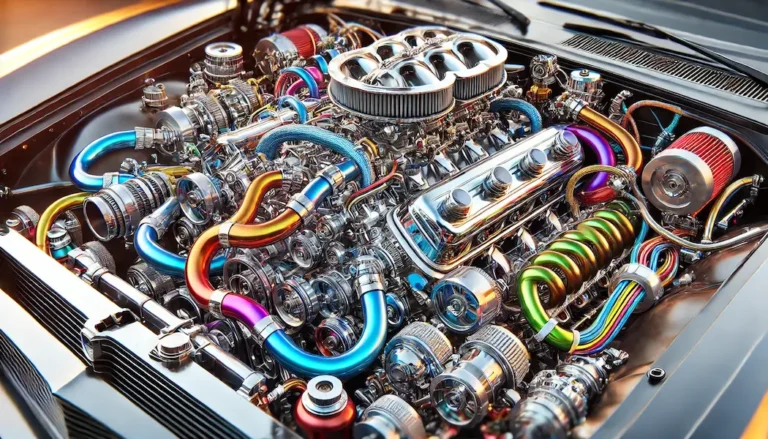Honda Check Engine Light: What It Means

Key Takeaway
If you own a Honda and notice the check engine light come on, it can be concerning. But don’t panic! Understanding what this light signifies and knowing how to respond can help you tackle potential issues effectively. This guide will walk you through what the check engine light means, common causes, and what steps you should take to resolve the issue. Let’s dive in!
Introduction
The check engine light (CEL) is one of those features in your car that can bring on a wave of anxiety. It’s like your vehicle’s way of saying, “Hey, something’s off!” Whether you’re a seasoned car owner or new to the driving scene, knowing what this light means and how to respond can save you a lot of headaches. In this article, I’ll break down the common reasons the check engine light might turn on, what you should do when it does, and share some personal experiences along the way.
What is the Check Engine Light?
The check engine light (CEL) is like your car’s way of waving a red flag. It tells you that something’s not quite right with the engine or emissions system. When the light pops up, it means the car’s computer has detected an issue that needs your attention.
Now, I remember the first time my check engine light came on. I was running errands, feeling pretty good about my day, when suddenly—BAM! There it was, glowing ominously on my dashboard. My heart raced. Was it serious? Would I be stuck on the side of the road?
The CEL can show up in a couple of ways:
- Solid Light: A steady glow typically indicates a non-urgent issue that should be addressed soon.
- Flashing Light: A blinking light is like your car yelling, “Stop right now!” This means there’s a serious problem, like an engine misfire, that requires immediate attention.
Understanding the distinction between these two signals is crucial for taking the right actions when the light comes on.
Common Reasons for the Check Engine Light
There are numerous reasons why the check engine light might activate in your Honda. Here are some of the most common causes:
1. Loose or Damaged Gas Cap
A surprisingly common reason for the check engine light is a loose or damaged gas cap. When the gas cap isn’t securely fastened or is cracked, it can allow fuel vapors to escape. This loss can lead to a drop in fuel efficiency and may trigger the CEL. Always make sure your gas cap is tightened properly after refueling.
2. Faulty Oxygen Sensor
The oxygen sensor plays a vital role in monitoring the amount of unburned oxygen in your car’s exhaust. It helps optimize fuel efficiency by ensuring the engine runs at the correct air-fuel ratio. If the sensor fails, it can lead to increased emissions and poor fuel economy.
I had a moment with this one. After a particularly long road trip, my fuel efficiency dropped drastically. Turns out, a faulty oxygen sensor was to blame. Replacing it was straightforward, but I wish I’d caught it earlier!
3. Malfunctioning Catalytic Converter
The catalytic converter helps reduce harmful emissions from your vehicle by converting them into less harmful substances before they exit the exhaust system. If this component malfunctions, it can lead to increased emissions and a significant drop in engine performance. Ignoring this issue can lead to costly repairs down the line, as a malfunctioning catalytic converter can also affect other engine components.
4. Worn Spark Plugs
Spark plugs ignite the fuel-air mixture in your engine’s cylinders. Over time, they can wear out, leading to misfires, poor acceleration, and reduced fuel efficiency. If your spark plugs are old or damaged, they may not create a strong enough spark to ignite the fuel properly.
Regular maintenance, including replacing spark plugs, can help prevent this issue from triggering the check engine light. I learned this the hard way when my Honda started stuttering during acceleration. A quick replacement fixed the problem!
5. Engine Issues
Serious engine problems, such as a misfire or internal failure, can also activate the check engine light. These issues may not be immediately apparent but can lead to significant damage if not addressed promptly. It’s essential to pay attention to any unusual sounds, smells, or changes in performance when the check engine light comes on, as these can indicate underlying engine problems.
6. Faulty Mass Airflow Sensor
The mass airflow (MAF) sensor measures the amount of air entering the engine, which is crucial for maintaining the correct air-fuel mixture. If this sensor fails, it can cause poor engine performance, reduced fuel economy, and an increase in emissions.
7. Exhaust Gas Recirculation (EGR) Valve Issues
The EGR valve helps reduce nitrogen oxide emissions by recirculating a portion of the exhaust gas back into the engine’s combustion chamber. If the EGR valve is clogged or malfunctioning, it can lead to increased emissions and engine performance problems.
8. Transmission Problems
In some cases, the check engine light can be triggered by transmission issues. Problems with the transmission can affect engine performance and lead to shifting problems. If the light comes on and you notice issues with acceleration or shifting, it’s vital to have your vehicle inspected.
What to Do When the Light Comes On
When the check engine light comes on, it’s essential to take appropriate action. Here’s a step-by-step guide on what to do next:
1. Check for Obvious Issues
Start by checking for any obvious issues that could be causing the light to illuminate. Here are a few quick checks you can perform:
- Gas Cap: Ensure the gas cap is tight and not damaged. If it’s loose, tighten it and see if the light turns off after a few trips.
- Look for Leaks: Inspect under your car for any fluid leaks, which could indicate a more serious issue.
2. Pay Attention to Performance
Notice any changes in how your vehicle drives. Are you experiencing poor acceleration, strange noises, or rough idling? Take note of these symptoms, as they can provide valuable information to your mechanic.
3. Scan for Error Codes
Many auto parts stores offer free diagnostic scanning services to read the error codes stored in your vehicle’s computer. These codes can provide insight into what triggered the check engine light. If you’re comfortable doing so, you can also purchase an OBD-II scanner to check the codes yourself. Having one handy gives you peace of mind and can save you time when that pesky light comes on.
4. Consult a Mechanic
If the check engine light remains on after checking the gas cap and performing basic checks, it’s best to consult a mechanic. They can run a more thorough diagnostic test, interpret the error codes, and recommend necessary repairs. It’s essential to address any issues as soon as possible to avoid further damage.
5. Don’t Ignore the Light
Even if your Honda seems to be running fine, don’t ignore the check engine light. Sometimes, problems can escalate quickly, leading to more extensive (and expensive) repairs down the line. Ignoring the light can also lead to reduced fuel efficiency and increased emissions, which can be harmful to the environment.
6. Keep a Maintenance Record
Maintain a record of any check engine light incidents, including what codes were retrieved, repairs made, and any recurring issues. This information can be valuable for future reference and can help your mechanic diagnose problems more efficiently.
7. Perform Regular Maintenance
Preventive maintenance is key to avoiding check engine light issues in the first place. Regularly servicing your vehicle, changing the oil, replacing air filters, and checking spark plugs can help keep your Honda running smoothly. Following the manufacturer’s maintenance schedule can significantly reduce the chances of the check engine light illuminating.
Common Myths About the Check Engine Light
There are several myths surrounding the check engine light that can lead to misunderstandings. Here are a few common misconceptions:
Myth 1: The Check Engine Light is Just a Reminder for Oil Changes
While the check engine light may illuminate due to various issues, it is not a reminder for routine maintenance like oil changes. It indicates a potential problem that requires attention.
Myth 2: You Can Ignore the Light if the Car Seems Fine
Many people believe they can ignore the check engine light if the car seems to be running normally. However, underlying issues can worsen over time, leading to more significant problems and costly repairs.
Myth 3: The Light Means You Need a New Engine
A check engine light does not automatically mean your engine is about to fail. It indicates a range of possible issues, many of which can be fixed without needing a full engine replacement.
Conclusion
The check engine light in your Honda serves as an important warning system for potential problems. By understanding what it means and knowing how to respond, you can keep your vehicle in good condition and avoid unnecessary repairs. If you ever find yourself unsure about the situation, don’t hesitate to consult a professional mechanic.
Trust me, your future self will thank you for being proactive! Regular maintenance and prompt attention to warning lights can save you time, money, and stress in the long run. Your Honda deserves the best care, and staying informed can help ensure a long and reliable life for your vehicle.
So, the next time that little light flickers to life on your dashboard, take a deep breath. You’ve got this!
FAQs
1. What should I do if my check engine light is on but my car seems fine?
It’s best not to ignore the light. Check for simple issues like a loose gas cap first. If that doesn’t help, consider getting a diagnostic scan to pinpoint the problem.
2. How much does it cost to fix a check engine light issue?
The cost can vary widely depending on the issue. Simple fixes like replacing a gas cap may only cost a few dollars, while more serious repairs, like replacing a catalytic converter, can run into the hundreds or thousands. It’s always a good idea to get a quote from a mechanic.
3. Can I drive my car with the check engine light on?
If the light is solid, you might be okay to drive for a short time, but it’s best to get it checked soon. If the light is flashing, stop driving immediately as this indicates a serious problem.
4. Will my check engine light reset itself?
Sometimes the light will reset on its own after a few driving cycles if the issue is resolved. However, if the problem persists, the light will likely come back on.
5. How can I prevent the check engine light from coming on?
Regular maintenance is key! Stay on top of oil changes, check your gas cap regularly, and keep an eye on your vehicle’s overall performance. A little proactive care can go a long way.
Thanks for checking out this article on EngineEcho.com! Hope you found this article: "Honda Check Engine Light: What It Means" helpful! If you liked it and want to dive into more car engine topics, head over to our homepage. There's always something new to discover in the world of engines. Enjoy your reading journey!
Check out our previous article: Where to Buy Big Block Chevy Engines






